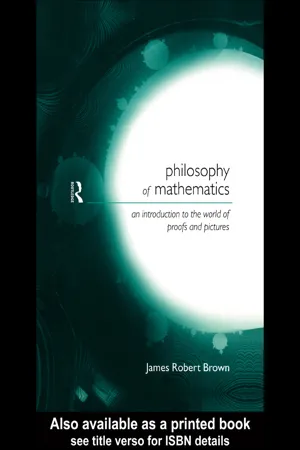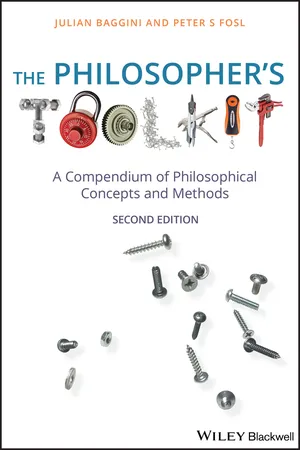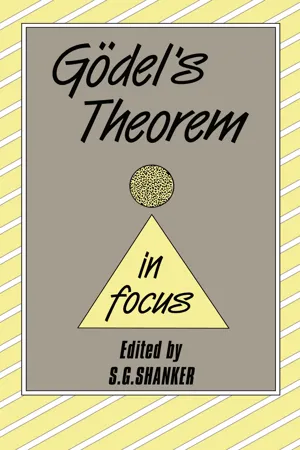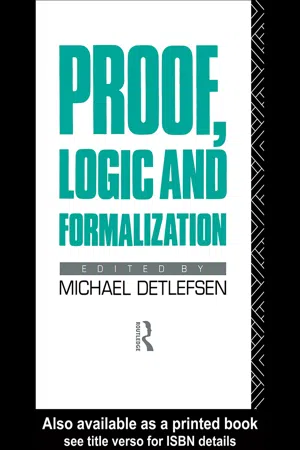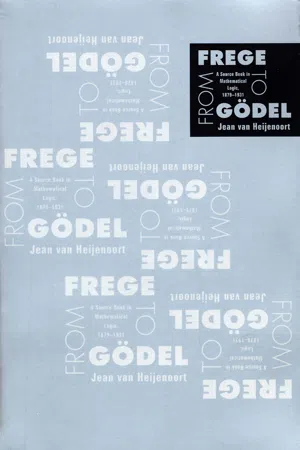Goedel Incompleteness Theorem
The Goedel Incompleteness Theorem, formulated by mathematician Kurt Goedel, states that in any formal system with enough complexity to express arithmetic, there will always be true statements that cannot be proven within that system. This has significant implications for computer science, as it demonstrates the inherent limitations of formal systems and the impossibility of creating a complete and consistent formal system for mathematics.
6 Key excerpts on "Goedel Incompleteness Theorem"
- eBook - ePub
Philosophy of Mathematics
An Introduction to a World of Proofs and Pictures
- James Robert Brown(Author)
- 2005(Publication Date)
- Routledge(Publisher)
...Certainty cannot be simply identified with the finite; at best it can be linked to the rather small. But if we confine ourselves to this, we won’t have anything close to the classical mathematics we want and need. Moreover, as Hilbert correctly noted, the universe is finite. So for some large but still finite number, there cannot be any appropriate perceptual experience (e.g. there aren’t enough ||||||…). Thus, even large finite numbers will have to be classified along with transfinite entities as fictions or ideal elements. On the other hand, perhaps these objections needn’t be seen as problems in principle with Hilbert’s programme. It might turn out that the consistency proofs that are required to justify classical mathematics all happen to be short and manageable. Of course, this is a moot point, since there are no such proofs – long or short. Gödel’s Theorem Gödel’s theorem, which shows the incompleteness of any attempt to systematize arithmetic, is perhaps the single most famous and important result in logic in this or any century. It is also one of the most difficult to understand. Recently, however, George Boolos has found a much simpler proof of the incompleteness theorem. The proofs of Gödel and Boolos are each modelled on famous, but different, paradoxes. Gödel makes use of the Liar Paradox (What I am now saying is false – a paradox because if true then it’s false, and if false then it’s true.) He formulates a sentence of arithmetic which says something like ‘I am not provable’, and sure enough it turns out to be unprovable, so it would seem to be a true but unprovable sentence of arithmetic, making the system of axioms incomplete...
- eBook - ePub
The Philosopher's Toolkit
A Compendium of Philosophical Concepts and Methods
- Julian Baggini, Peter S. Fosl(Authors)
- 2011(Publication Date)
- Wiley-Blackwell(Publisher)
...The reality is that, unless you’ve studied mathematics at a very high level, you probably don’t understand what Godel’s theorem means, let alone what its implications are for other areas of philosophy. For a start, there are actually two theorems, the second of which is a corollary of the first. According to Simon Singh in Fermat’s Last Theorem (1997), a mathematically accurate statement of the first theorem is ‘To every w-consistent recursive class k of formulae there correspond recursive class-signs r such that neither v Gen r nor neg (v Gen r) belongs to Flg(k) (where v is the free variable of r).’ A more comprehensible, but already somewhat simplified, version of this is that in any formal, consistent logical system capable of describing arithmetic there is at least one sentence that can neither be proved nor disproved within the system. Why is this so stunning? The explanation of this is partly historical. At the turn of the last century Gottlob Frege and Bertrand Russell had both produced work of the highest calibre and reputation as part of a project aiming to show that every mathematical truth was provable in precisely the way Gödel showed it to be impossible. Hence Gödel’s theorem provided a devastating and fatal blow to the Russellian project of subsuming mathematics within logic. General application More generally, the lesson of Gödel is often taken to be that you just can’t prove everything. That’s fine as far as it goes. But Gödel’s theory doesn’t tell you what you can’t prove, except for the specific areas of mathematics to which the theorem applies. Even the claim that every consistent theory must contain at least one statement that is not provable within that theory goes beyond the strict confines of Gödel’s theorem, which only applies to the formalization of arithmetic...
- eBook - ePub
- S.G. Shanker, S.G. Shanker(Authors)
- 2012(Publication Date)
- Routledge(Publisher)
...Post (1936, 1943), A.A. Markov (1951), Kleene (1959) and J.C. Sheperdson and H.E. Sturgis (1963). Gödel lent his assent to the generalized Gödel theorems in the words of the following ‘Note added 28 August 1963’ to the translation of his paper (1931) in van Heijenoort (1967): In consequence of later advances, in particular of the fact that due to A.M. Turing’s work a precise and unquestionably adequate definition of the general notion of formal system can now be given, a completely general version … is now possible. That is, it can be proved rigorously that in every consistent formal system that contains a certain amount of finitary number theory there exist undecidable arithmetic propositions and that, moreover, the consistency of any such system cannot be proved in the system. I have dwelt on developments growing out of Gödel’s work to illustrate how seminal his ideas and results have been. I will conclude my discussion of his discovery of formally undecidable propositions by quoting from what John von Neumann said on 14 March 1951, on the occasion of an award of an Einstein medal to Gödel: ‘Kurt Gödel’s achievement in modem logic is singular and monumental — indeed it is more than a monument, it is a landmark which will remain visible far in space and time’ (New York Times, 15 March 1951, p. 31). Before passing to the third of Gödel’s major contributions that I am discussing in detail, I will mention a number of observations that he contributed to the study of intuitionistic systems. In (1932) he showed that the intuitionistic propositional calculus cannot be treated on the basis of finitely many truth values. In (1932-3) he showed that it is possible to paraphrase every theorem in classical number theory by one in intuitionistic number theory; specifically, ∃xA(x) is paraphrased as ¬ ∀x ¬ A(x), A v B as ¬ (¬ A & ¬ B), and A ⊃ B as ¬ (A & ¬ B). (Later Bernays, and Gentzen (1936, p...
- eBook - ePub
- Michael Detlefsen(Author)
- 2005(Publication Date)
- Routledge(Publisher)
...4 HOW TO SAY THINGS WITH FORMALISMS David Auerbach SUMMARY Recent attention to “self-consistent” (Rosser-style) systems raises anew the question of the proper interpretation of the Gödel Second Incompleteness Theorem and its effect on Hilbert’s Program. The traditional rendering and consequence is defended with new arguments justifying the intensional correctness of the derivability conditions. I The conception of formalism as uninterpreted, but interpretable, systems that was wavering into focus during the 1920s achieved clarity in Gödel’s 1931 paper. The historical irony here is that while this clarity fulfilled one of Hilbert’s demands for firm foundations, the Gödel results themselves have been seen as frustrating Hilbert’s central epistemological desire. Due in part to Hilbert’s vagueness in formulating his demands, and in part to the subtlety of the issues involved, there remains an ongoing debate as to whether the First Incompleteness Theorem scuttled Hilbert’s Program, whether only the Second did, or whether neither did. Leaving detailed exegesis of Hilbert aside, I propose to investigate some very general issues that arise in the course of such debate. Hilbert wanted to save mathematics from Kronecker’s constructivist critique, a critique made pointed by the antinomies of set theory. Hilbert, however, shared some of Kronecker’s basic epistemological scruples and thus proposed, on one interpretation of his project, to salvage the nonconstructivist part of mathematics by making it meaningless but helpful. This instrumentalist reading of Hilbert is arguable. Or rather, “meaningless” might be taken only as Fregean meaningless. It is not that the nonfinitary mathematics is true because, inter alia, its terms refer, but that its terms refer because it is true. The Hilbert Program then aims at making sense of this notion of truth prior to reference. This would make Hilbert what we would now call a meaning-holist...
- eBook - ePub
From Frege to Gödel
A Source Book in Mathematical Logic, 1879-1931
- Jean van Heijenoort(Author)
- 2002(Publication Date)
- Harvard University Press(Publisher)
...The theorem states that in a formal system satisfying certain precise conditions there is an undecidable proposition, that is, a proposition such that neither the proposition itself nor its negation is provable in the system. Before coming to the core of the argument, Gödel takes a number of preparatory steps: (1) A precise description of the system P with which he is going to work. The variables are distinguished as to their types and they range over the natural numbers (type 1), classes of natural numbers (type 2), classes of classes of natural numbers (type 3), and so forth. The logical axioms are equivalent to the logic of Principia mathematica without the ramified theory of types. The arithmetic axioms are Peano’s, properly transcribed. The identification of the individuals with the natural numbers and the adjunction of Peano’s axioms (instead of their derivation, as in Principia) have the effect that every formula has an interpretation in classical mathematics and, if closed, is either true or false in that interpretation; moreover, proofs are considerably shortened. (2) An assignment of natural numbers to sequences of signs of P and a similar assignment to sequences of sequences of signs of P. The first assignment is such that, given a sequence, the number assigned to it can be effectively calculated, and, given a number, we can effectively decide whether the number is assigned to a sequence and, if it is, actually write down the sequence; similarly for the second assignment. By means of these assignments we can correlate number-theoretic predicates with metamathematical notions used in the description of the system; for example, to the notion “axiom” corresponds the predicate Ax (x), which holds precisely of the numbers x that are assigned to axioms (the “Gödel numbers” of axioms, we would say today). (3) A definition of primitive recursive functions (Gödel calls them recursive functions) and the derivation of a few theorems about them...
- eBook - ePub
- Ernest Nagel, James R. Newman(Authors)
- 2012(Publication Date)
- Routledge(Publisher)
...Moreover, they are essentially incomplete: even if G were added as a further axiom, the augmented set would still not suffice to yield formally all arithmetical truths. For, if the initial axioms were augmented in the suggested manner, another true but undecidable arithmetical formula could be constructed in the enlarged system; such a formula could be constructed merely by repeating in the new system the procedure used originally for specifying a true but undecidable formula in the initial system. This remarkable conclusion holds, no matter how often the initial system is enlarged. We are thus compelled to recognize a fundamental limitation in the power of the axiomatic method. Against previous assumptions, the vast continent of arithmetical truth cannot be brought into systematic order by laying down once for all a set of axioms from which every true arithmetical statement can be formally derived. (v) We come to the coda of Gödel’s amazing intellectual symphony. The steps have been traced by which he grounded the meta-mathematical statement: ‘If arithmetic is consistent, it is incomplete’. But it can also be shown that this conditional statement taken as a whole is represented by a demonstrable formula within formalized arithmetic. This crucial formula can be easily constructed. As we explained in Section V, the meta-mathematical statement ‘ Arithmetic is consistent’ is equivalent to the statement There is at least one formula of arithmetic that is not demonstrable’. The latter is represented in the formal calculus by the following formula, which we shall call ‘ A’: (A) (∃y)(x) ∼ Dem (x, y) In words, this says: ‘ There is at least one number y such that, for every number x, x does not stand in the relation Dem to y’. Interpreted meta-mathematically, the formula asserts: There is at least one formula of arithmetic for which no sequence of formulas constitutes a proof’...
